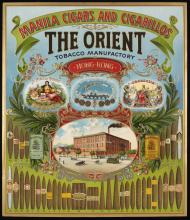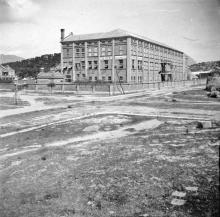Current condition
Demolished / No longer exists
Date completed
(Day & Month are approximate.)
The factory was completed in 1908 (see point 35 of the PWD Annual Report for 1908: "A Cigar Factory on K.I.L. 1203, Yaumati, was completed.")
The site is shown on the 1920 map, labeled "The Orient Tobacco Factory".
The 1941 Juror's List uses the "Manufactory" name, and lists several staff:
| c | Almeida, Jose Maria d' | Accountant, Orient Tobacco Manufactory | 582 Nathan Road, Kow1oon. |
| c | Basto, Arthur Jose de Castro | Clerk, Orient Tobacco Manufactory | 8 Humphrey's Avenue, Kowloon. |
| c | Tavastjerna, George Alexander | Store Manager, Orient Tobacco Manufactory | 228 Nathan Road, Kowloon. |
Hugh has gathered further information about the factory at http://industrialhistoryhk.org/orient-tobacco-manufactury-company/



Comments
Children's working conditions at the factory in 1921
This factory was included in the review of children's working conditions in 1921, and the interview with the manager is recorded on page 131:
Mr. Seiling, Manager, Orient Tobacco Factory—Mong Kok Tsui.
We employ from 500 to 600 hands, of whom 24 are children. There are 18 girls and 6 boys. The ages are as follows:—
1 of 12 years
9 from 12 to 14 years
14 „ 14 to 16 „
The children are day workers, they earn about 12 cents a day. They work 9 hours a day for 6 days a week. The children are the children of adults in our factory. I prefer children as we can train them. There is no overtime and no Sunday work. They work from 7-12 and 1-5. Most of our old hands came to us as girls and were trained by us. We have wages lists and could send returns. The pay of an adult is from 50 cents to $1 a day.
The full document is available at HKGRO: "REPORT OF THE COMMISSION APPOINTED TO ENQUIRE INTO THE CONDITIONS OF THE INDUSTRIAL EMPLOYMENT OF CHILDREN IN HONGKONG, AND THE DESIRABILITY AND FEASIBILITY OF LEGISLATION FOR THE REGULATION OF SUCH EMPLOYMENT."
1910 Oriente Tobacco Manufactory
Mention is made here of the operation of the Oriente Tobacco Manufactory in the Hong Kong Telegraph dated 29 January 1910. Scroll to Page 2.
Notes on the The Orient Cigar poster
The poster very probably dates back to 1910 – 1914 and was obviously designed to promote the sale of the cigars of The Orient, the Hong Kong affiliate of the firm started by Carl Ingenohl in the 1870’s.
Carl Ingenohl founded a tobacco plantation and cigar manufacturing company in the Philippines in the Isabella Valley in the 1870’s with relatively modest financial backing from his mother and later on his cousin. The early years must have been quite difficult, but the business soon prospered, driven by Carl Ingenohl’s entrepreneurial dynamism and a whole range of cigars were produced using different brands. La Perla del Oriente was the premium brand and Grandasia was the mid-market brand. The cigars were no doubt sold in several markets in South East Asia, but the US was an important export market and no doubt cigars were also sold in the European markets. Carl Ingenohl himself was based in Antwerp, but travelled regularly to the Far East. Shortly after Hong Kong leased the New Territories from China in 1899, Carl Ingenohl decided to build a second and larger cigar manufacturing plant in Kowloon. Apparently the cigars produced in Hong-Kong with Philippine tobacco were better than the ones produced in Manila… This may be attributable to the fact that the Hong-Kong factory was built with the experience developed over the years in the Manila factory, was built with far more money (all the spaces in the factory where cigars were made or stored were entirely cedarwood lined apparently!), but possibly also due to difficult to measure climatic conditions that may have been more favourable to the cigars.
A site was acquired as a grant on 1st January 1908. The factory was located in Kowloon on a site that totalled over 300,000 sq. ft. and was bordered by Nathan Street, Dundas Street, Soy Street and Kwong Wa Street. The streets have retained their names to this day and are near the Mong Kok station. The factory was built in 1908 and started production in 1909. Although the Hong Kong company that owned the factory was put under administration during the war, it reverted back to the ownership of the Orient Syndicate, a partnership of which Carl Ingenohl was the General Partner, after the First World War and probably continued to operate until the outbreak of the Second World War. During the Second World War the factory was looted under the Japanese occupation of Hong Kong and never resumed production. The site was sold for property development in the early 1950’s.
The Manila factory and the plantations were confiscated by the Americans when they liberated the Philippines in spite of the fact that Carl Ingenohl was a Belgian citizen. The reason for the confiscation was that Carl Ingenohl’s brother had been the Admiral in Chief of the German European Fleet during the First World War and another brother was a high ranking officer. Carl Ingenohl fought for 10 years in the courts to recover the unjustly seized property and finally won several cases, including one in front of the U.S. Supreme Court in 1927. Unfortunately he lost an important trademark infringement case against Olsen, the company to which the US authorities had sold the Manila factory and plantations. Under Olsen’s ownership the Manila operations managed to get a contract to supply China with 24 million cigars, and that must not have been their only client. That gives an idea of the scale of the cigar operations of El Oriente, particularly if one considers that the Hong-Kong factory was probably larger than the Manila one.
"An office boy from the…
"An office boy from the Oriental Cigar Factory at Yaumati was convicted at the Magistracy yesterday of stealing cigars and sent to prison for 14 days."
Source: Hong Kong Daily Press, page 2, 24th August 1911